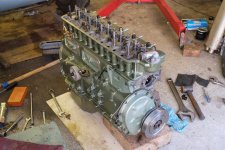BN6_2197
Jedi Trainee
Offline
Gents,
I fitted an oil temperature gauge into my BN6. Since I use the car for classic car rallyes I felt more comfortable with knowing the temperature. When I did m first test drives, I was wondering that the gauge showed about 110 degress Celsius (about 230 degree Farenheit). In my opinion tht is very high. Any opinion on that? I use 20w50 Catrol Classic motor oil.
Volker
I fitted an oil temperature gauge into my BN6. Since I use the car for classic car rallyes I felt more comfortable with knowing the temperature. When I did m first test drives, I was wondering that the gauge showed about 110 degress Celsius (about 230 degree Farenheit). In my opinion tht is very high. Any opinion on that? I use 20w50 Catrol Classic motor oil.
Volker

 Hi Guest!
Hi Guest!

 smilie in place of the real @
smilie in place of the real @
 Pretty Please - add it to our Events forum(s) and add to the calendar! >>
Pretty Please - add it to our Events forum(s) and add to the calendar! >> 

